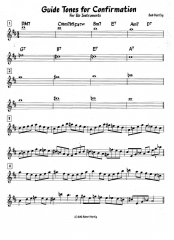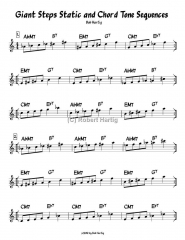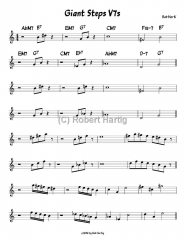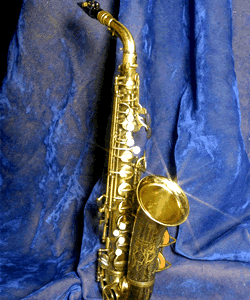In recent months I set myself to tackling a project that I had put off far, far too long: getting my arms around Bird changes. In one way or another, the Charlie Parker tune “Confirmation” has been a regular part of my practice sessions these days. Recently I finished transcribing a Richie Cole solo on “Confirmation,” and of course that was enlightening. I’m currently in the process of memorizing both it and a Parker solo on the changes. It has all been profitable in unlocking the logical but nevertheless challenging harmonies.
Developing a set of guide tones is immensely helpful in mastering Bird changes, particularly in the first four bars. The exercises on this page will help you do so. Click on the image to enlarge it. Note that the exercises are written for Eb instruments. If your instrument is pitched differently–eg. Bb tenor sax or C flute–you’ll need to transpose accordingly.
In exercises one and two, I’ve stripped the guide tones down to a whole note for every bar. You can modify them as you wish, but I find it helpful to start by keeping things as simple as possible.
Exercises three and four take the form of boppish etudes that utilize the guide tones.
I highly recommend that you practice these exercises with some form of harmonic accompaniment so you can hear how the pitches sound in context with the actual chord progression.
That’s it–gotta scoot. I hope you find these little nuggets profitable. If you enjoy them, you’ll find plenty more on my jazz improv page.









 Over thirty years have passed from the days of God’s Family Band until today. Dad’s horn has been a constant companion in that journey, though I have not always been constant with it. There were times when I set it aside for a season, and other times when I thought how much simpler life could be if I put it behind me forever. Yet every time I have set down the saxophone, I have returned to it. I have kept at it–because I must. It is more than a passion; it is a calling, integral to the way God has designed me.
Over thirty years have passed from the days of God’s Family Band until today. Dad’s horn has been a constant companion in that journey, though I have not always been constant with it. There were times when I set it aside for a season, and other times when I thought how much simpler life could be if I put it behind me forever. Yet every time I have set down the saxophone, I have returned to it. I have kept at it–because I must. It is more than a passion; it is a calling, integral to the way God has designed me.
